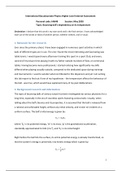Presentation
IB Physics HL Internal Assessment (Scored 23/24 points) (IB Physics level 7 IA)
- Course
- Institution
A comprehensive IB Physics HL Internal Assessment that can be replicated in terms of its general content, structure, and approach. This piece of writing was externally graded by IB examiners in the May 2020 session and scored level 7 (23/24 points). Following the sample can guarantee very high perf...
[Show more]



